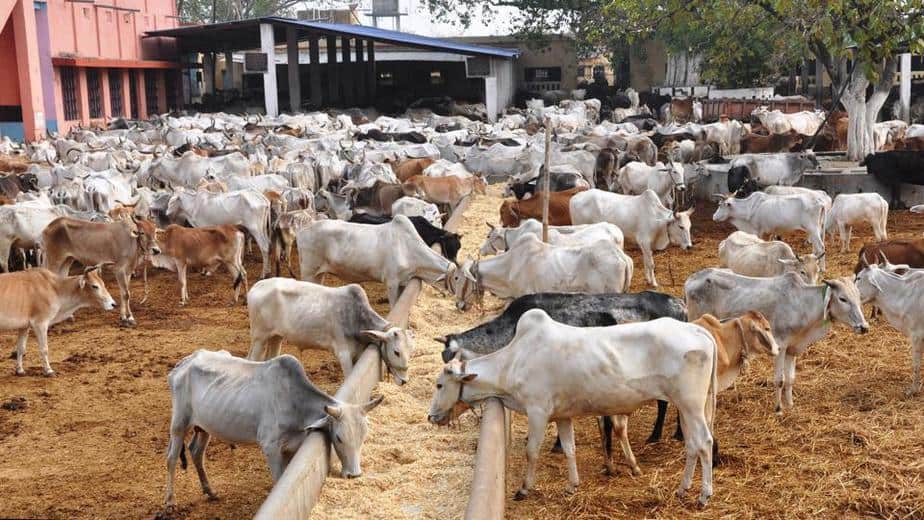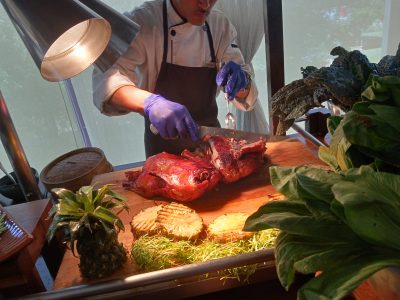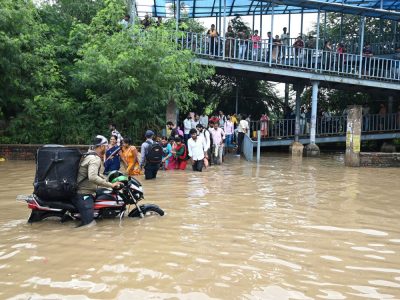Marred with financial irregularities and overcrowding, cow shelters stand neglected even as hundreds of cows continue to die every year in these shelters due to lack of fodder and medical care
Cramped to the helm with miserably bony cows, either injured or old, some with wounds that have become infected probably because they were left untreated — the conditions in Delhi’s cow shelters are so unhygienic, it leaves one wondering if they are really built to protect ‘gau matas’.
Lying in pool of dung and urine, these ‘highly venerated’ cows look extremely frail and feeble. This might not hold true for every gaushala (cow shelter) but conditions in most of these shelters are pitiful. In the land where cows are worshipped, where lynching under the garb of cow protection and cow politics in the name of saving cows from slaughter are frequent, a visit to these shelters uncover the ghastly reality of cow protection in India.
Shri Krishna Gaushala (government-funded) in North West Delhi’s Bawana currently holds more than 8,000 cows. “Most of the cows that are brought here are old or injured. Cows die because they are already reeling under diseases due to the ingestion of plastic, which is a major problem,” says Raghuvir Singh, a worker at this gaushala. “Sometimes when there is an outbreak of a serious disease, the situation exacerbates because the cows inflicted with disease need space to heal but the gaushala is overcrowded, so the spread of diseases escalates and there isn’t enough space to put the cows in quarantine.”
Reportedly, all the five government-funded cow shelters in Delhi are filled beyond their capacity. Overcrowding aggravates the unhygienic conditions.
In many gaushalas across India, cows are being reduced to bones and their living conditions are horrifying. Media reports reveal that 18,000 cows have died in shelters since 2012.
In July this year, 48 cows were found dead in South West Delhi’s Acharya Sushil Muni Gaushala in Dwarka, which is one of the five government funded cow shelters in the capital. The number rose to 60 by the second week of August, after which the facility was sealed and the remaining cows were shifted to another cow shelter, Dabar Hare Krishna Gaushala, which is the largest government-aided cow shelter in the capital.
Even as political parties are vouching to protect cows, hailing it as a goddess, they have turned a deaf ear to its misery. According to the data collected by the municipal corporations, in 2015-16 South Delhi Municipal Corporation (SDMC) sent 3,398 cattle to shelters and 3,685 died during the same period. In 2014-15, 2,974 cattle were sent and 2,143 died.
Starvation is a major concern at these shelters. The caretaker of Manav Gosadan (in Rewla Khanpur), Giriraj Sinha, reveals that they do not have green fodder, so many cows also die due to lack of proper fodder as they become extremely weak. The government allocates funds but the managers at these shelters say that due to lack of funds there is a shortage of green fodder. Only dry fodder is being fed.
A manager at Gopal Gosadan in Harewali village on the outskirts of Delhi, on condition of anonymity, says, “The health of the animals brought here is bad. They are mostly old cows who have been abandoned as they can no longer produce milk. We do not have enough funds to deal with the situation.”
The Delhi government and the MCD are spending Rs 14,600 per cow per year on these centres, according to media reports. The government funded cow shelters get Rs 40 per animal per day. Even though a lot of money is being sanctioned for these cow shelters, the managers allege that funds have not been released since months. Mismanagement and financial disputes characterize most of these shelters now, with cow deaths increasing by the day.
In the last three years, SDMC has released Rs 5 crore to three of the government shelters in Delhi. But managers and workers at gaushalas claim that they do not have sufficient funds to handle the overcrowding, terming it their biggest obstacle. “The feeding costs have increased, so the funds should be revised,” says the manager of the gaushala.
He further says, “People do not donate to the government aided shelters, thinking that we have generous government funds. So they donate mostly to private cow shelters. We also do not have as many helpers as the number of cows. Managing old and ailing cows becomes difficult without adequate help.”
Hundreds of cows have been dying in gaushalas across the country but no steps have been taken to regulate this. “Will this not be termed cow slaughter? Most of these cow shelters do not have veterinarians and the animals are starved as they are not even being fed properly. Reports can prove that most of the deaths in these cow shelters have been due to starvation or lack of medicines,” says Renu Jain, an activist for animal rights organisation PETA (People for the Ethical Treatment of Animals).
Another recent incident highlights the reality of cow protection in India. To clear the way for the installation of a television screen for PM Modi’s live speech on September 15 in a village in Madhya Pradesh, 450 cows were allegedly moved out of a gaushala, which led to the death of eight cows due to starvation and several others have fallen ill. When the news went viral on social media, the situation was again politicized without examining the larger issue of cow protection.
This week, the Chief Minister of Madhya Pradesh, Shivraj Singh Chauhan, made a commitment of setting up a cow ministry. A few days back, Uttarakhand became the first state in the country to officially pass a resolution to accord the status of ‘rashtra mata’ to the cow to ensure safety of cows across the country. Amidst all the politics around cows, these poor creatures are living in wretched conditions in gaushalas and the ones on the streets are feeding on plastic. Their plight is being neglected.
Gauri Kumar, a Delhi-based activist working for animal welfare says, “Cow protection is being used as a tool for political leverage, instead of treating it like an issue of animal welfare. Cow vigilantes are taking law in their hands on the pretext of protecting cows from being slaughtered. But how many of them can volunteer and work in these cow shelters? How many can adopt old cows who are abandoned?”
Considering the poor upkeep of these gaushalas and the high mortality rates, in December last year, Maneka Gandhi drew up a standard operating procedure for the running of shelters. In the foreword to her gaushala manual, Maneka says: “A gaushala may have a mandir (temple) in it venerating the cow, but it rarely has a sick bay in which the animal is treated.” She further adds, “Majority of the gaushalas in the country are poorly run where the old and abandoned animals are herded in one small enclosure. The mortality rate in gaushalas is 10 per cent a month. After some time gaushalas degenerate into semi-dairies. The group controlling the gaushalas start segregating the milking cows from the old and sick ones. The former are fed better, made to breed and the milk is collected and distributed among these people.”
As protection of cows is at the core of the Hindutva agenda, political controversies have engulfed it, so much so that the actual problem remains hidden. “People are fighting over cows and their slaughtering, but what are the conditions in these gaushalas? Why doesn’t anyone address this issue?” questions Vicky Misra, a volunteer working with animal welfare non-profit Jeev Ashray, adding, “The conditions at most of the gaushalas are deplorable. Guidelines should be framed and such shelters should be remodeled, bringing them under a vigilant check.”
Cowed into agony
– In 2016, more than 500 cows died within 10 days at the Hingonia cow shelter in Rajasthan. The figures are staggering: between January and August 2016, a total of 8,122 cows died in this shelter.
– In July 2017, gaushalas in Jalore district of Rajasthan saw the death of about 700 cows.
– In July last year, 152 cows died within five months at one of the biggest gaushalas in Kanpur. An autopsy report pointed at empty intestines — that the cows had not eaten anything and were anemic — triggering allegations of siphoning of funds as the Kanpur gaushala reportedly had more than adequate funds.
– In August 2017, 200 cows died due to starvation and lack of medicines at a shelter run by BJP leader Harish Verma who said that the deaths were due to a wall collapse.





